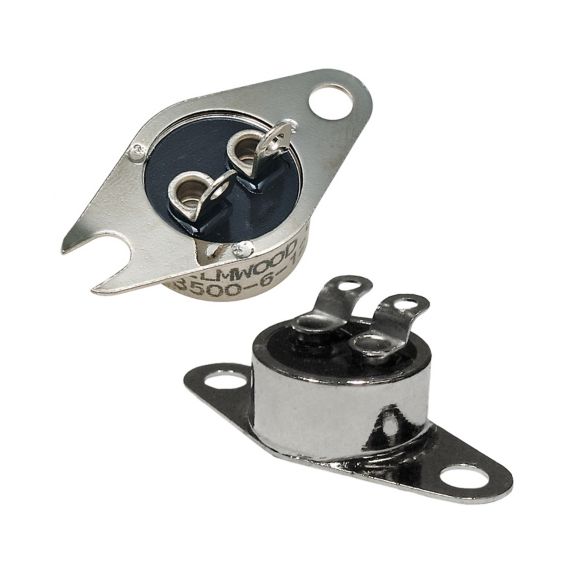Thermostats
3500 Series
Military. Hermetically sealed. Tight tolerances & differentials. SPST contacts. Mounting brackets, terminals
The 3500 Series consists of a single pole, single throw switch activated by a snap action bimetal disc. Temperature calibrations are pre-set at the factory, and each unit is 100% thermally and mechanically inspected. It is available to open or close on temperature rise. The case is laser welded to form a hermetically sealed steel housing, with a glass-to-metal seal at the terminal junction. It meets or exceeds the requirements of MIL-S- 24236 and is designed specifically for military and commercial aircraft applications. It is not QPL listed (see 3MS1).
Features
- Hermetically sealed
- Tight tolerances
- Tight differentials
- Hi-Rel
Potential Applications
- Military and commercial aircraft
Others
- Dielectric Strength
- MIL-STD-202, Method 301; 1250 Vac 60 Hz - Terminal to Case
- Thermostat Environmental Exposure Range
- -65 °C to 260 °C [-85 °F to 500 °F]
- Shock
- MIL-STD-202, Method 213; 400 G
- Insulation Resistance
- MIL-STD-202, Method 302; 500 MOhm
- Humidity
- MIL-STD-202, Method 106
- Agency Approvals and Standards
- MIL-PRF-24236
- Meets or exceeds requirements of MIL-PRF-24236
- Acceleration Range/Limits
- MIL-STD-202, Method 212; 20 G
- Thermostat Contact Resistance
- MIL-STD-202, Method 307; 0.050 Ohm
- MIL-STD-202, Method 307; 0.050 Ohm max.
- Thermal Shock
- MIL-STD-202, Method 107; Cond. B
- Operating temperature
- -46 °C to 204 °C [-50 °F to 400 °F]
- -51 °C to 204 °C [-60 °F to 400 °F]
- Vibration
- MIL-STD-202, Method 204; 20 G
- Seal Type
- MIL-STD-202, Method 112; Cond. C
- Salt Spray
- MIL-STD-202, Method 101; Cond. B
Others
- Dielectric Strength
- MIL-STD-202, Method 301; 1250 Vac 60 Hz - Terminal to Case
- Thermostat Environmental Exposure Range
- -65 °C to 260 °C [-85 °F to 500 °F]
- Shock
- MIL-STD-202, Method 213; 400 G
- Insulation Resistance
- MIL-STD-202, Method 302; 500 MOhm
- Humidity
- MIL-STD-202, Method 106
- Agency Approvals and Standards
- MIL-PRF-24236
- Meets or exceeds requirements of MIL-PRF-24236
- Acceleration Range/Limits
- MIL-STD-202, Method 212; 20 G
- Thermostat Contact Resistance
- MIL-STD-202, Method 307; 0.050 Ohm
- MIL-STD-202, Method 307; 0.050 Ohm max.
- Thermal Shock
- MIL-STD-202, Method 107; Cond. B
- Operating temperature
- -46 °C to 204 °C [-50 °F to 400 °F]
- -51 °C to 204 °C [-60 °F to 400 °F]
- Vibration
- MIL-STD-202, Method 204; 20 G
- Seal Type
- MIL-STD-202, Method 112; Cond. C
- Salt Spray
- MIL-STD-202, Method 101; Cond. B
- Dielectric Strength : MIL-STD-202, Method 301; 1250 Vac 60 Hz - Terminal to Case
- Thermostat Environmental Exposure Range : -65 °C to 260 °C [-85 °F to 500 °F]
- Shock : MIL-STD-202, Method 213; 400 G
- Insulation Resistance : MIL-STD-202, Method 302; 500 MOhm
- Humidity : MIL-STD-202, Method 106
- Agency Approvals and Standards : MIL-PRF-24236|Meets or exceeds requirements of MIL-PRF-24236
- Acceleration Range/Limits : MIL-STD-202, Method 212; 20 G
- Thermostat Contact Resistance : MIL-STD-202, Method 307; 0.050 Ohm|MIL-STD-202, Method 307; 0.050 Ohm max.
- Thermal Shock : MIL-STD-202, Method 107; Cond. B
- Operating temperature : -46 °C to 204 °C [-50 °F to 400 °F]|-51 °C to 204 °C [-60 °F to 400 °F]
- Vibration : MIL-STD-202, Method 204; 20 G
- Seal Type : MIL-STD-202, Method 112; Cond. C
- Salt Spray : MIL-STD-202, Method 101; Cond. B





















